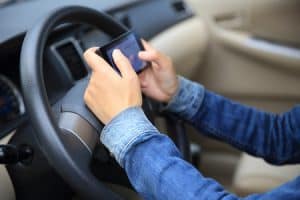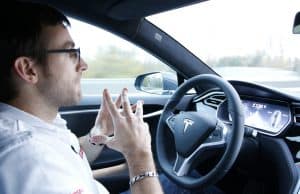[profileleft] [/profileleft]By now everyone should understand that texting and driving is extremely dangerous. The vast majority of jurisdictions in the United States outlaw this act on some level. That’s because the statistics are clear: texting and driving causes car accidents that lead to serious injuries and fatalities. Unfortunately, people still send and read text messages while driving with alarming regularity.
[/profileleft]By now everyone should understand that texting and driving is extremely dangerous. The vast majority of jurisdictions in the United States outlaw this act on some level. That’s because the statistics are clear: texting and driving causes car accidents that lead to serious injuries and fatalities. Unfortunately, people still send and read text messages while driving with alarming regularity.
Despite all of the laws, all of the public service efforts and all of the awareness campaigns designed to minimize texting and driving, hundreds of thousands of people are injured every year in crashes because of this mistake. Some people have begun wondering why this problem not only persists, but seemingly is getting worse. The Auto Insurance Center recently completed a survey on why motorists text while behind the wheel. Hopefully this information will help some realize that they need to put their phones down when driving.
About the Texting and Driving Study
Auto Insurance Center is essentially a news service intended to inform readers with regards to trends in driving safety and other related issues. The group conducted a survey of 2,060 motorists regarding their texting habits while they drive. The survey probed several different aspects of texting and driving, and one of those aspects involved reasons why drivers texted while behind the wheel. The answers they gave were as follows:
- More than 25 percent stated that they felt pressure to respond quickly to a significant other, family member or friend.
- Nearly 19 percent of motorists texted while driving because they were making plans.
- More than 17 percent of those surveyed texted while behind the wheel because they don’t want to take too long to respond to messages in general.
- More than 15 percent of motorists responded to texts because they were looking for directions.
- Nearly 11 percent of motorists admitted to texting and driving because they were bored.
- Almost 9 percent of those surveyed felt pressure to respond to a work-related text message.
- More than 3 percent of motorists responded to texts because they were lonely.
These answers cover a wide array of reasons or excuses for texting and driving, but the bottom line is that they upped the risk level they and others in the area at the time were facing regardless of why they were engaging in this behavior. Those who wish to review the full breakdown of the survey can find it here.
Other Texting and Driving Survey Responses
The survey also asked motorists about the most common text messages they tend to send while behind the wheel. Below are the 10 most common responses in order:
- Running late
- Minutes late
- Send me that address
- Coming home
- Heading home
- I’ll call
- Months ago
- Red light
- Stuck in traffic
- Weeks ago
The survey also uncovered the notion that parents are not generally setting a positive example for their children in terms of texting and driving. More than half of all parents surveyed admitted to texting and driving. The breakdown of the frequency of texts by parent appears below:
Mothers
- Always – 25.35 percent
- Usually – 12.28 percent
- Sometimes – 12.67 percent
- Rarely – 7.52 percent
- Never – 42.18 percent
Fathers
- Always – 9.78 percent
- Usually – 13.88 percent
- Sometimes – 17.35 percent
- Rarely – 12.62 percent
- Never – 46.37 percent
It’s shocking that nearly three times as many mothers admitted to texting and driving on a regular basis than did fathers. Regardless, children will mimic the behaviors of their parents and all parents need to keep this in mind when they drive.
Finally, it seems that the dangers of texting and driving have hit home with quite a few people despite the information above. We can see that from the responses from people regarding how they feel as passengers when the person driving is texting. Those responses are broken down by gender below:
Women
- Very unsafe – 45.82 percent
- Unsafe – 41.89 percent
- Neutral – 10.53 percent
- Safe – 0.93 percent
- Very safe – 0.83 percent
Men
- Very unsafe – 35.61 percent
- Unsafe – 43.28 percent
- Neutral – 18.18 percent
- Safe – 1.89 percent
- Very safe – 1.04 percent
Almost 88 percent of women and more than 78 percent of men feel either unsafe or very unsafe when they are passengers and their drivers are texting.
Texting and Driving – Daunting Statistics
The survey also revealed the three most common final texts that motorists sent before being involved in a fatal car accident. These three messages included:
- Driving drunk
- I’ll be dead
- I love you
These are all chilling messages, and based on the statistics regarding accidents that involve texting and driving they are sent way too often. According to Distraction.gov, more than 3,000 people died in car accidents in 2014 alone in crashes involving distracted drivers. According to IceBike.org, more than 75 percent of all distracted driving-caused car accidents that lead to injury involve someone texting and driving. If that ratio is consistent, then it’s possible that more than 2,200 people are killed in car accidents in the United States every year because of texting and driving.
How a San Diego Car Accident Lawyer Can Help
The numbers regarding texting and driving should startle anyone who sees them for the first time and prompt them to stop making this mistake if it’s one that they make even periodically. Yet, an enormous number of people still send and read text messages when they are behind the wheel. Our firm has discussed the prevalence of this problem recently. There is more than can be done to help deter drivers from engaging in this dangerous conduct. Private citizens who are injured or who lose loved ones in crashes caused by distracted drivers need to take their own steps to hold those drivers accountable.
One way that you can do your part to help improve safety on the roads is to take action if you have suffered because someone was texting and driving. You need to seek the help of a San Diego car accident lawyer who understands what it takes to help clients fight for and obtain justice.
Contact Gomez Trial Attorneys today to schedule a free initial consultation.







